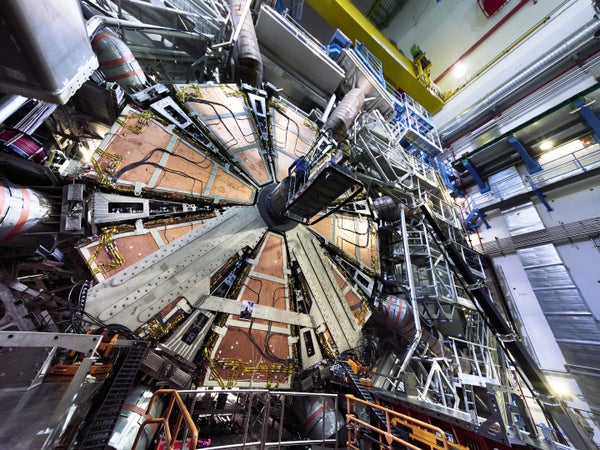September 25, 2024
4 min read
‘Spooky Action at a Distance’ Observed in Quarks for the First Time
Physicists report the first observations of quantum entanglement in quarks, the heaviest known fundamental particles, inside the Large Hadron Collider
The ATLAS detector, part of the Large Hadron Collider, sits 100 meters below ground, where it measures various properties of high-energy particles.
Scientists have for the first time observed quantum entanglement — a state in which particles intermingle, losing their individuality so they can no longer be described separately — between quarks. The feat, achieved at CERN, Europe’s particle-physics laboratory near Geneva, Switzerland, could open the door to further probes of quantum information in particles at high energies.
Entanglement has been measured in particles such as electrons and photons for decades, but it is a delicate phenomenon and easiest to measure in low-energy, or ‘quiet’, environments, such as in the ultracold refrigerators that house quantum computers. Particle collisions, such as those between protons at CERN’s Large Hadron Collider, are comparatively noisy and high-energy, making it much harder to measure entanglement from their debris — like listening for a whisper at a rock concert.
To observe entanglement at the LHC, physicists working on the ATLAS detector analysed about one million pairs of top and anti-top quarks — the heaviest of all known fundamental particles and their antimatter counterparts. They found statistically overwhelming evidence for entanglement, which they announced in September last year, and describe in detail today in Nature. Physicists working on the LHC’s other main detector, CMS, also confirmed the entanglement observation in a report posted to the preprint server arXiv in June.
On supporting science journalism
If you’re enjoying this article, consider supporting our award-winning journalism by subscribing. By purchasing a subscription you are helping to ensure the future of impactful stories about the discoveries and ideas shaping our world today.
“It is really interesting because it’s the first time you can study entanglement at the highest possible energies obtained with the LHC,” says Giulia Negro, a particle physicist at Purdue University in West Lafayette, Indiana, who worked on the CMS analysis.
Scientists have had no doubt that top-quark pairs can be entangled. The standard model of particle physics — the current best theory of fundamental particles and forces through which they interact — is built atop quantum mechanics, which describes entanglement. But the latest measurement is nonetheless valuable, researchers say.
“You don’t really expect to break quantum mechanics, right?”, says Juan Aguilar-Saavedra, a theoretical physicist at the Institute of Theoretical Physics in Madrid. “Having an expected result must not prevent you from measuring things that are important.”
Transient tops
During a coffee break years ago, Yoav Afik, an experimental physicist now at the University of Chicago in Illinois, and Juan Muñoz de Nova, a condensed-matter physicist now at Complutense University of Madrid, wondered if it was possible to observe entanglement at a collider. Their chat turned into a paper that laid out a path to measure entanglement using top quarks.
Pairs of top and anti-top quarks created in the aftermath of a proton collision live infinitesimally short lives — lasting 10−25 seconds. Then they decay into longer-lived particles.
Previous studies had found that during their short lives, top quarks can have correlated ‘spin’, a quantum property similar to angular momentum. Afik and Muñoz de Nova’s realization was that this measurement could be extended to show that top-quark spins were not somewhat correlated, but truly entangled. They defined a parameter, D, to describe the degree of correlation. If D was less than −1/3, the top quarks would be entangled.
Part of what eventually made Afik and Muñoz de Nova’s proposal work is the top quarks’ short lifetime. “You could never do this with lighter quarks,” says James Howarth, an experimental physicist at the University of Glasgow, UK, who was part of the ATLAS analysis along with Afik and Muñoz de Nova. Quarks truly dislike being separated, so after a mere 10−24 seconds, they start mixing with each other to form hadrons such as protons and neutrons. But a top quark decays quickly enough that it doesn’t have time to ‘hadronize’ and lose its spin information through mixing, Howarth says. Instead, all of that information “gets transferred to its decay particles”, he adds. This meant that the researchers could measure the properties of decay products to work backwards and infer the properties, including spin, of the parent top quarks.
After making an experimental measurement of the top-quark spins, the teams compared their results with theoretical predictions. But the models of top-quark production and decays didn’t match the detector measurements.
Researchers at both ATLAS and CMS grappled with the uncertainties in different ways. The CMS team, for example, found that adding ‘toponium’ — a hypothesized state in which a top and anti-top quark are bound together — to its analyses helped theory and experiment to agree better.
In the end, both experiments easily met the −1/3 entanglement limit, with ATLAS measuring D to be −0.537 and CMS measuring −0.480.
Topping off
The success in observing entanglement in top quarks could improve researchers’ understanding of top-quark physics and pave the way for future high-energy tests of entanglement. Other particles, such as the Higgs boson, could even be used to perform a Bell test, an even more rigorous probe of entanglement.
The top-quark experiment might shift thinking among physicists, Afik says. “At the beginning it was a bit hard to convince the community” that the study was worth the time, he says. After all, entanglement is a bedrock of quantum mechanics and has been verified time and again.
But the fact that entanglement hasn’t been rigorously explored at high energies is justification enough for Afik and the phenomenon’s other aficionados. “People have realized that you can now start to use hadron colliders and other types of colliders for doing these tests,” Howarth says.
This article is reproduced with permission and was first published on September 18, 2024.

